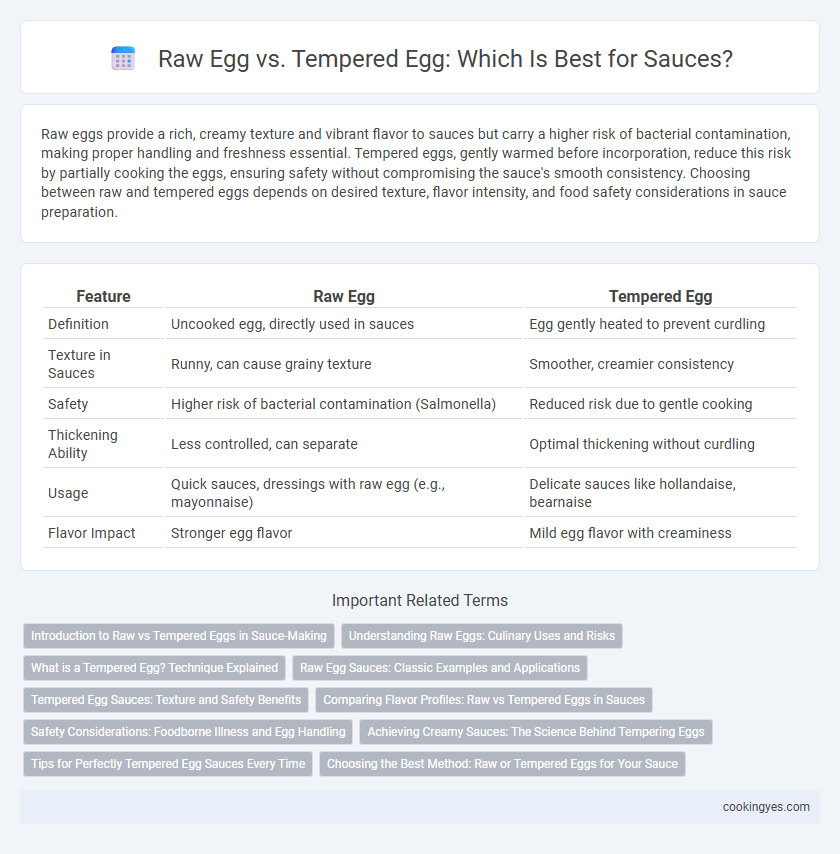Raw eggs provide a rich, creamy texture and vibrant flavor to sauces but carry a higher risk of bacterial contamination, making proper handling and freshness essential. Tempered eggs, gently warmed before incorporation, reduce this risk by partially cooking the eggs, ensuring safety without compromising the sauce's smooth consistency. Choosing between raw and tempered eggs depends on desired texture, flavor intensity, and food safety considerations in sauce preparation.
Table of Comparison
| Feature | Raw Egg | Tempered Egg |
|---|---|---|
| Definition | Uncooked egg, directly used in sauces | Egg gently heated to prevent curdling |
| Texture in Sauces | Runny, can cause grainy texture | Smoother, creamier consistency |
| Safety | Higher risk of bacterial contamination (Salmonella) | Reduced risk due to gentle cooking |
| Thickening Ability | Less controlled, can separate | Optimal thickening without curdling |
| Usage | Quick sauces, dressings with raw egg (e.g., mayonnaise) | Delicate sauces like hollandaise, bearnaise |
| Flavor Impact | Stronger egg flavor | Mild egg flavor with creaminess |
Introduction to Raw vs Tempered Eggs in Sauce-Making
Raw eggs provide a rich, creamy texture essential in sauces like hollandaise and mayonnaise, but carry a risk of bacterial contamination such as Salmonella. Tempered eggs, heated gradually to a safe temperature, ensure food safety while maintaining the desired consistency and preventing curdling. Understanding the balance between raw and tempered eggs is crucial for achieving smooth, stable sauces with optimal flavor and texture.
Understanding Raw Eggs: Culinary Uses and Risks
Raw eggs provide a rich, silky texture essential for classic sauces like hollandaise and mayonnaise, but they carry a potential risk of salmonella contamination, especially when not pasteurized. Tempered eggs, gently heated to reduce bacterial hazards while preserving their emulsifying properties, offer a safer alternative without compromising sauce quality. Chefs prioritize proper handling and temperature control to maintain both food safety and optimal consistency in egg-based sauces.
What is a Tempered Egg? Technique Explained
Tempering eggs involves slowly mixing hot liquid into raw eggs to gradually raise their temperature, preventing curdling when added to sauces. This technique stabilizes the eggs, allowing them to thicken sauces smoothly and safely without scrambling. Properly tempered eggs contribute to a creamy texture and enhanced richness in classic sauces like hollandaise or custards.
Raw Egg Sauces: Classic Examples and Applications
Raw egg sauces like mayonnaise, hollandaise, and Caesar dressing rely on uncooked eggs to provide a rich, creamy texture and emulsifying properties essential for consistency. These sauces require fresh, high-quality raw eggs to ensure safety and prevent bacterial contamination, often sourced from pasteurized eggs or prepared under strict hygiene conditions. The delicate flavor and smooth mouthfeel achieved with raw eggs make them indispensable in classic culinary applications where heat would otherwise alter the sauce's texture or taste.
Tempered Egg Sauces: Texture and Safety Benefits
Tempered egg sauces achieve a creamy, smooth texture by gradually raising the egg's temperature, preventing curdling and ensuring a stable emulsion. This method enhances safety by reducing the risk of salmonella contamination commonly associated with raw eggs. Popular sauces like hollandaise and custards rely on tempered eggs to balance flavor, texture, and food safety.
Comparing Flavor Profiles: Raw vs Tempered Eggs in Sauces
Raw eggs in sauces offer a rich, creamy texture with a slightly metallic undertone, enhancing the sauce's natural flavors while maintaining a silky consistency. Tempered eggs, gently cooked by gradually mixing with warm ingredients, develop a deeper, more complex flavor and a smoother, custard-like texture that can elevate the overall taste experience. The tempering process reduces the risk of raw egg taste and creates a balanced flavor profile preferred in classic sauces like hollandaise and custards.
Safety Considerations: Foodborne Illness and Egg Handling
Raw eggs pose a higher risk of foodborne illnesses such as Salmonella, demanding stringent handling and proper storage to minimize contamination. Tempered eggs are gently heated to reduce pathogens while preserving texture, enhancing safety without fully cooking the egg. Careful temperature control and hygiene practices are critical when incorporating eggs into sauces to ensure food safety.
Achieving Creamy Sauces: The Science Behind Tempering Eggs
Tempering eggs involves gradually warming raw eggs by slowly adding hot liquid, preventing curdling and creating a smooth, creamy texture essential for sauces like hollandaise and custard. Raw eggs, when directly exposed to high heat, coagulate quickly, leading to grainy or scrambled results rather than silky emulsions. The science behind tempering hinges on controlled protein denaturation, enabling eggs to thicken sauces uniformly without curdling.
Tips for Perfectly Tempered Egg Sauces Every Time
Tempering raw eggs before adding them to sauces prevents curdling and ensures a smooth, creamy texture by gradually raising their temperature. Slowly whisking a small amount of hot liquid from the sauce into the raw eggs while continuously stirring tempers the eggs effectively. Consistent heat control and immediate incorporation into the sauce off the heat help achieve perfectly tempered egg sauces every time.
Choosing the Best Method: Raw or Tempered Eggs for Your Sauce
Choosing the best egg method for sauces hinges on texture and safety; raw eggs offer a creamy, rich consistency but carry a risk of salmonella, while tempered eggs provide a safer option by gradually heated tempering that prevents curdling and ensures smoothness. Tempering eggs stabilizes them, making sauces like hollandaise or custard more reliable and silky without the grainy texture raw eggs sometimes produce. For a balance of flavor and food safety, tempered eggs are preferred in delicate sauces requiring gentle heat control.
Raw egg vs Tempered egg for sauces Infographic

 cookingyes.com
cookingyes.com